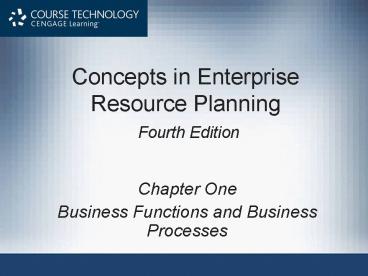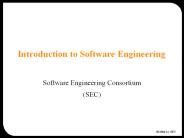Concepts in Enterprise Resource Planning Fourth Edition - PowerPoint PPT Presentation
1 / 44
Title:
Concepts in Enterprise Resource Planning Fourth Edition
Description:
Concepts in Enterprise Resource Planning Fourth Edition Chapter One Business Functions and Business Processes ... – PowerPoint PPT presentation
Number of Views:397
Avg rating:3.0/5.0
Title: Concepts in Enterprise Resource Planning Fourth Edition
1
Concepts in Enterprise Resource Planning Fourth
Edition
- Chapter One
- Business Functions and Business Processes
2
Objectives
- After completing this chapter, you will be able
to - Name the main functional areas of operation used
in business - Differentiate between a business process and a
business function - Identify the kinds of data each main functional
area produces - Identify the kinds of data each main functional
area needs - Define integrated information systems, and
explain why they are essential in todays
globally competitive business environment
3
Introduction
- Enterprise Resource Planning (ERP) programs Core
software used by companies to coordinate
information in every area of business - Help manage companywide business processes
- Use common database and shared management
reporting tools - Business process Collection of activities that
takes some input and creates an output that is of
value to the customer
4
Functional Areas and Business Processes
- To understand ERP, you must understand how a
business works - Functional areas of operation
- Business processes
5
Functional Areas of Operation
- Marketing and Sales (M/S)
- Supply Chain Management (SCM)
- Accounting and Finance (A/F)
- Human Resources (HR)
- Business functions Activities specific to a
functional area of operation
6
Functional Areas of Operation (contd.)
Figure 1-1 Examples of functional areas of
operation and their business functions
7
Functional Areas of Operation (contd.)
- Functional areas are interdependent
- Each requires data from the others
- Better integration of functional areas leads to
improvements in communication, workflow, and
success of company - Information system (IS) Computers, people,
procedures, and software that store, organize,
and deliver information
8
Business Processes
- Collection of activities that takes one or more
kinds of input and creates an output that is of
value to customer - Customer can be traditional external customer or
internal customer - Thinking in terms of business processes helps
managers to look at their organization from the
customers perspective
9
Business Processes (contd.)
Figure 1-2 Sample business processes related to
the sale of a personal smartphone
10
Business Processes (contd.)
- Businesses must always consider customers
viewpoint in any transaction - Successful customer interaction
- Customer (either internal or external) is not
required to interact with each business function
involved in the process - Successful business managers view business
operations from the perspective of a satisfied
customer
11
Business Processes (contd.)
- Sharing data effectively and efficiently between
and within functional areas leads to more
efficient business processes - Integrated information systems Systems in which
functional areas share data
12
Business Processes (contd.)
Figure 1-3 A process view of business
13
Business Processes (contd.)
- Businesses take inputs (resources) and transform
these inputs into goods and services for
customers - Inputs Material, people, equipment
- Managing inputs and business processes
effectively requires accurate and up-to-date
information
14
Functional Areas and Business Processes of a Very
Small Business
- Example A fictitious coffee shop
- Examine business processes of the coffee shop
- See why coordination of functional areas helps
achieve efficient and effective business
processes - Look at how integration of the information system
improves the business
15
Marketing and Sales
- Functions of Marketing and Sales
- Developing products
- Determining pricing
- Promoting products to customers
- Taking customers orders
- Helping create a sales forecast
16
Marketing and Sales (contd.)
- Marketing and Sales tasks for the coffee shop
- Formal recordkeeping not required
- Need to keep track of customers
- Product development can be done informally
- Good repeat customers allowed to charge
purchasesup to a point - Records must show how much each customer owes and
his or her available credit
17
Supply Chain Management
- Functions within Supply Chain Management
- Making the coffee (manufacturing/production)
- Buying raw materials (purchasing)
- Production planning requires sales forecasts from
M/S functional area - Sales forecasts Analyses that attempt to predict
the future sales of a product
18
Supply Chain Management (contd.)
- Production plans used to develop requirements for
raw materials and packaging - Raw materials Bottled spring water, fresh
lemons, artificial sweetener, raw sugar - Packaging Cups, straws, napkins
- SCM and M/S must choose a recipe for each coffee
product sold
19
Accounting and Finance
- Functions within Accounting and Finance
- Recording raw data about transactions (including
sales), raw material purchases, payroll, and
receipt of cash from customers - Raw data Numbers collected from sales,
manufacturing and other operations, without any
manipulation, calculation, or arrangement for
presentation
20
Accounting and Finance (contd.)
- Data from Accounting and Finance used by
Marketing and Sales and Supply Chain Management - Sales records are important component of sales
forecast - Sales forecast is used in making staffing
decisions and in production planning - Records from accounts receivable used to monitor
the overall credit-granting policy of the coffee
shop
21
Human Resources
- Functions of Human Resources
- Recruit, train, evaluate, and compensate
employees - HR uses sales forecasts developed by the
individual departments to plan personnel needs - Systems integrated using ERP software provide the
data sharing necessary between functional areas
22
Functional Area Information Systems
- Potential inputs and outputs for each functional
area described next - Note the kinds of data needed by each area and
how people use the data - Information systems maintain relationships
between all functional areas and processes
23
Marketing and Sales
- Needs information from all other functional areas
- Customers communicate orders to M/S in person or
by telephone, e-mail, fax, the Web, etc. - M/S has a role in determining product prices
- Pricing might be determined based on a products
unit cost, plus some percentage markup - Requires information from Accounting and Finance,
and Supply Chain Management data
24
Marketing and Sales (contd.)
Figure 1-4 The Marketing and Sales functional
area exchanges data with customers and with the
Human Resources, Accounting and Finance, and
Supply Chain Management functional areas
25
Marketing and Sales (contd.)
- M/S needs to interact with Human Resources to
exchange information on hiring needs, legal
requirements, etc. - Inputs for M/S
- Customer data
- Order data
- Sales trend data
- Per-unit cost
- Company travel expense policy
26
Marketing and Sales (contd.)
- Outputs for M/S
- Sales strategies
- Product pricing
- Employment needs
27
Supply Chain Management
- Needs information from various functional areas
- Production plans based on information about
product sales (actual and projected) that comes
from Marketing and Sales - With accurate data about required production
levels - Raw material and packaging can be ordered as
needed - Inventory levels can be kept low, saving money
28
Supply Chain Management (contd.)
- Supply Chain Management data and records can
- Provide data needed by Accounting and Finance to
determine how much of each resource was used - Support the M/S function by providing information
about what has been produced and shipped - Supply Chain Management interacts in some ways
with Human Resources
29
Supply Chain Management (contd.)
Figure 1-5 The Supply Chain Management
functional area exchanges data with suppliers and
with the Human Resources, Marketing and Sales,
and Accounting and Finance functional areas
30
Supply Chain Management (contd.)
- Inputs for SCM
- Product sales data
- Production plans
- Inventory levels
- Layoff and recall company policy
31
Supply Chain Management (contd.)
- Outputs for SCM
- Raw material orders
- Packaging orders
- Resource expenditure data
- Production and inventory reports
- Hiring information
32
Accounting and Finance
- Needs information from all other functional areas
- A/F personnel
- Record companys transactions in the books of
account - Record accounts payable when raw materials are
purchased and cash outflows when they pay for
materials - Summarize transaction data to prepare reports
about companys financial position and
profitability
33
Accounting and Finance (contd.)
- People in other functional areas provide data to
A/F - M/S provides sales data
- SCM provides production and inventory data
- HR provides payroll and benefit expense data
- M/S personnel require data from A/F to evaluate
customer credit
34
Accounting and Finance (contd.)
Figure 1-6 The Accounting and Finance functional
area exchanges data with customers and with the
Human Resources, Marketing and Sales, and Supply
Chain Management functional areas
35
Accounting and Finance (contd.)
- Inputs for A/F
- Payments from customers
- Accounts receivable data
- Accounts payable data
- Sales data
- Production and inventory data
- Payroll and expense data
36
Accounting and Finance (contd.)
- Outputs for A/F
- Payments to suppliers
- Financial reports
- Customer credit data
37
Human Resources
- HR needs information from the other departments
- Tasks related to employee hiring, benefits,
training, and government compliance are all
responsibilities of HR - HR needs accurate forecasts of personnel needs
from all functional units - HR needs to know what skills are needed to
perform a particular job and how much the company
can afford to pay employees
38
Human Resources (contd.)
Figure 1-7 The Human Resources functional area
exchanges data with the Accounting and Finance,
Marketing and Sales, and Supply Chain Management
functional areas
39
Human Resources (contd.)
- Observing governmental regulations in recruiting,
training, compensating, promoting, and
terminating employees - Inputs for HR
- Personnel forecasts
- Skills data
40
Human Resources (contd.)
- Outputs for HR
- Regulation compliance
- Employee training and certification
- Skills database
- Employee evaluation and compensation
41
Human Resources (contd.)
- Significant amount of data is maintained by and
shared among the functional areas - Timeliness and accuracy of these data critical to
each areas success and to companys ability to
make a profit and generate future growth - ERP software allows all functional areas to share
a common database - Allows accurate, real-time information to be
available
42
Summary
- Basic functional areas Marketing and Sales,
Supply Chain Management, Accounting and Finance,
and Human Resources - Marketing and Sales Sets product prices,
promotes products through advertising and
marketing, takes customer orders, supports
customers, and creates sales forecasts - Supply Chain Management Develops production
plans, orders raw materials from suppliers,
receives raw material, manufactures products,
maintains facilities, and ships products to
customers
43
Summary (contd.)
- Accounting and Finance Financial accounting to
provide summaries of operational data in
managerial reports, controlling accounts,
planning and budgeting, and cash-flow management - Human Resources Recruits, hires, trains, and
compensates employees, ensures compliance with
government regulations, and oversees the
evaluation of employees - Information systems capture, process, and store
data to provide information needed for decision
making
44
Summary (contd.)
- Employees working in one functional area need
data from employees in other functional areas - Functional area information systems should be
integrated, so shared data are accurate and
timely - Managers think in terms of business processes
that integrate the functional areas - Need to share information between functions and
functional areas - ERP software provides this capability by means of
a single common database































